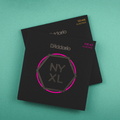5 Guitar Lessons You Can Learn From Eric Clapton
By Strings Direct – 29 August, 2023

It is difficult to overstate the impact that Eric Clapton has had on the blues. Clapton was one of the key figures in the British blues movement, and has inspired generations of guitarists over the course of his 60-year career.
From his technique, to his gear, to his approach to practice - there is a lot that we can learn from 'Slowhand'. This is particularly so because unlike so many of his contemporaries, Clapton has continually adapted his playing and style over the years.
In fact he has done this to such an extent that his music appeals to a huge spectrum of people; from aspiring rock and blues guitar players to fans with a much softer and more pop oriented musical taste.
As such, here I have tried to look at techniques and ideas that have remained consistent throughout Clapton’s playing, as well as some of the ideas that are specific to his earlier years with the Bluesbreakers and Cream, and his later solo career.
Without further ado then, here are 5 key lessons you can learn from Eric Clapton that will make you a better blues guitarist:
Mix & Match Pentatonics
It is easy to become overly reliant on the minor pentatonic scale. The scale works so well, is easy to learn and implement in your playing and has come to define the sounds of the blues. Yet if you are not careful, relying on the minor pentatonic can cause your playing to become repetitive and stale.
To get out of this musical rut, a lot of guitarists start looking at modes and more exotic scales. Before that point however, I think it is first useful to look at the major pentatonic scale. Properly utilising the major pentatonic scale will transform your playing. It will give your soloing a completely new sound and will greatly increase your musical palette.
Mixing the major pentatonic scale alongside the minor pentatonic is something that Clapton has done consistently throughout his career. It is a huge part of his sound and is evident in almost all of his lead playing.
Some of my favourite examples where you can hear this mix are in the heavier blues rock songs that Clapton recorded with the Bluesbreakers and Cream. In the song 'Steppin' Out' for example, Clapton mixes the G minor and G major pentatonic scales to create a variety of licks that mix the two tonalities. And in the song ‘Crossroads’ Clapton does the same - this time in the key of A.
If you are new to the major pentatonic scale, then the good news is that the shapes of the major pentatonic scale are exactly the same as those of the minor pentatonic scale. The only difference is where they appear on the fretboard. In the key of A for example, the shapes of the A major pentatonic scale are as follows:

As you can hopefully see, the shapes of the A major pentatonic scale are exactly the same as those of the A minor pentatonic scale. The only difference is that each shape appears 3 frets lower.
Now, because the actual notes of the major pentatonic scale are different to those of the minor pentatonic scale, you can’t just take your minor pentatonic scale licks and move them down 3 frets. The major pentatonic scale is a separate scale and needs to be treated as such.
To cover mixing the two scales in depth is beyond the scope of this article. However if you are in a position where you are looking to use the major pentatonic scale in your playing, learning some of the songs listed above will help to build your repertoire and give you a framework for using the major pentatonic scale when soloing.
Float Like A Butterfly. Eric Clapton's floating vibrato technique.
I was lucky enough to see Eric Clapton playing live a number of years ago. And when I did, I was struck by his 'floating' vibrato technique.
Typically, you execute vibrato by anchoring your hand and thumb on the back of your guitar neck, and moving your fretting finger. With what I call floating vibrato however, you move your hand off the back of the guitar neck. So the only point of contact with your guitar is your fretting finger.
This creates a very particular sound. When your hand is anchored to the guitar, you control the sound of your vibrato using your wrist. With floating vibrato however, you control your vibrato using your whole arm. And this creates a different cadence and therefore a different sound in your vibrato.
Clapton seems to favour this approach to produce quite a wide but smooth and flowing vibrato. You can see this in action in this clip of his opening solo for 'Old Love'. And if you study his later live performances you will often see him utilise the same technique.
If you are looking for more detail, then I would recommend watching this brilliant video of guitarist Greg Koch showing what this technique looks like in a bit more detail.
If you are not used to this style of vibrato, it can feel a little unusual at first. But stick with it. It will help you to nail those Clapton style tones, as well as develop a more subtle and nuanced approach to lead guitar playing.
As a final point, it is worth noting that John Mayer also uses this same vibrato style. So if you are a fan of John Mayer’s playing you can use this floating vibrato technique to recreate the feel of Mayer’s solos too.

Take Control. How Eric Clapton uses the tone and volume controls on his guitar.
Like all great blues guitarists, Clapton shapes his sound by using the tone and volume controls on his guitar. This might sound obvious, however I am often surprised by how many guitarists overlook the importance of their guitar’s tone and volume controls when it comes to dialling in their tone.
Clapton’s focus on shaping his tone on his guitar is one that has remained consistent throughout his career. However he used it most prominently in his early career to dial in what became known as the ‘woman tone’.
If you want to dial in that same tone, which you can hear on Cream songs like ‘I Feel Free', SWLABR, the beginning of 'White Room' and 'Sunshine Of Your Love', try taking the following steps:
- Crank the volume on your amp and get it to the point where the amp is starting to overdrive
- On your guitar, select either your neck pickup, or both your neck and bridge pickups together
- Roll the tone controls on your guitar all the way down to 0 or 1
- Roll the volume control on your guitar up to 10
Of course, the effectiveness of these steps will depend on the rest of your rig. And if you are interested in recreating this tone and are looking for a little more detail, head over to this article here, where I cover the key elements of Clapton’s rig during his early career.
Whether or not you are trying to recreate the ‘woman tone’ however, I hope that Clapton’s approach helps to remind you of the importance of your guitar’s tone and volume controls. Your guitar is always the first stage in your signal chain. As such, I would recommend focusing on maximising the tonal shaping possibilities there before you start looking at new guitar pedals, or other areas of your setup.
More Is More. Combining multiple techniques.
Part of what makes Eric Clapton such a skilled blues guitarist is his ability to combine multiple different techniques within very tightly defined phrases. This totally changes the feel of his playing. It also allows him to extract a lot of mileage from very simple note groupings.
Just look at this phrase from Clapton's first solo on Cream's cover of 'Crossroads' (this particular phrase is played at the 1.35 minute mark in the song):

Clapton's note choice here is very simplistic. He is moving between the first and second positions of the A minor pentatonic scale and adding just a single note from the A major pentatonic scale.
Yet as you can also see, Clapton embellishes almost every note with a hammer on, pull off, bend or slide. These techniques are densely packed into the phrase and the result is a very effective series of licks. This shows not only how much mileage you can get out of a handful of notes, but also how important techniques like bending and sliding are for effective blues soloing.
Of course, you can't play in this way all of the time. Effective blues soloing is about creating and releasing tension, and exercising restraint when it is right to do so. And in his later career - when Clapton somewhat moved away from the more aggressive and faster paced solos of his Bluesbreakers and Cream days - he also adopted this approach in much of his playing.
Even then though - and in songs like ‘Cocaine’, ‘Old Love’ and ‘Bad Love’ - Clapton typically uses a lot of these lead guitar techniques in quick succession to keep his solos varied and interesting.
So when you are thinking about soloing and improvising, think about utilising all of the techniques you have at your disposal. This will give your playing a more expressive feel and will breathe life into movements you make across scale shapes.

Create Motifs
For most of us, continually creating fresh ideas when soloing is challenging. It is easy to run out of material and to find yourself repeating the same licks and ideas. Not only can this be frustrating for you as a player, but it is often an ineffective way of improvising.
When you solo in this way, you don’t provide your listener with a central and recognisable theme. Instead there is a risk that you end up bombarding them with lick after lick, and as a result your solos can feel like a collection of licks, rather than a single and coherent structure.
One effective way of resolving this issue is to use a motif when soloing.
A motif - or motive as it is sometimes called - is a short musical idea that is repeated throughout a piece of music. Through its repetition, the motif becomes a distinctive and recognisable part of the piece.
The term is used much more frequently in Western classical music, where motifs are quite common. There are many famous examples of motifs in Western classical music, however arguably the most famous and instantly recognisable motif of all is that which is used in ‘Beethoven's Symphony No.5’.
The piece famously starts out with a 4 note phrase which is then repeated throughout the symphony. When it repeats however, there is often some change to the initial idea. The motif develops and alters. And in this way the symphony tells a story and takes you on a journey, whilst never straying too far away from its opening idea.
This idea has been repeated in a variety of genres and musical styles. And Eric Clapton often uses it in his playing. Perhaps the most obvious example of this is his famous motif in the song ‘Wonderful Tonight’.
Clapton takes that central idea, which he establishes from the very beginning of the song. He then continues to develop and return to this idea as the song continues. In live versions of the song, Clapton extends this idea by crafting longer solos which move away from the central idea. But he always returns to that main theme. And in this way he creates a sense of movement in his playing, whilst also reiterating an effective and memorable musical idea.
So if you struggle to create solos which hang together coherently - or you find yourself quickly running out of licks - try to implement this same idea in your playing.
Take one of your ‘go-to’ licks and base your solo around that lick. Establish the motif at the beginning of the solo, and then work on altering and developing the idea as the solo continues.
This will help you to get much more mileage from your ‘go-to’ licks and phrases. And in turn you will be able to solo more effectively and for longer periods of time.
* * * * *
ABOUT THE AUTHOR






